Thinkific is just one of several platforms you can build your creator business on. And if you’re reading this, you’re likely on the hunt for something a little more user-friendly, feature-rich, and, most importantly, a platform you can commit to in the long run.
The right video subscription website platform does more than host your courses; it can help you increase revenue, keep your audience engaged, and simplify how you manage memberships and content.
This article covers 10 Thinkific alternatives worth considering, exploring the core features and functionality you’ll need as a content creator with a growing business. Plus, we’ve included reviews and ratings on each platform from real creators like you.
What is Thinkific?
Thinkific is an online learning platform for businesses and creators to design and sell courses, coaching, memberships, communities, webinars, digital content, and other educational products. It offers 4 plans to suit different needs, ranging from $49 to $399 per month.
Some of Thinkific’s key features include:
- Course creation tools like a drag-and-drop builder for designing multimedia lessons, quizzes, and assignments with ease
- Learning community elements like discussion forums and spaces for learners to share insights and encourage collaboration
- Customizable site design to improve functionality and appearance based on your preferences, with third-party apps available for extra features and enhancements
- Mobile accessibility features to improve responsiveness, allowing students to access courses on the go with branded mobile apps for a personalized experience
- Marketing and sales tools, including sales pages, checkout pages, and abandoned cart recovery, to drive conversions and manage revenue effectively
Thinkific makes it easy to create and sell courses with built-in tools for lessons, quizzes, and community engagement, but many creators look for alternatives to better unify their content, memberships, and video offerings in one platform while maximizing revenue potential.
Best Thinkific alternatives overview
These platforms offer different approaches to online courses and digital products, making it easier to find the Thinkific alternative that fits your needs.
| Platform | Best for | Cost | G2 Rating |
| Uscreen | Video and course creators scaling revenue | Starting at $149/mo | 4.7 |
| Teachable | Course creators and coaches | Free plan with paid plans from $39/mo | 4 |
| Podia | Digital products, webinars, courses | Free plan with paid plan from $4/mo | 4.4 |
| Kartra | Marketing and selling digital products | Starting at $99/mo | 3.9 |
| Udemy | New creators or creators without an audience | Starting at $14/mo | 4.5 |
| Kaltura | Enterprise educational video creation | Quote on request | 4.3 |
| LearnDash | Interactive online courses | Starting at $29/mo | 4.7 |
| Kajabi | Marketing and selling digital products | Starting at $81/mo | 4.3 |
| Mighty Networks | Community-driven memberships and learning | Starting at $129/mo | 4.6 |
1. Uscreen
Best for: Video-based creators who want to scale their revenue.
G2 rating: 4.7 out of 5
Uscreen is ideal for video creators who want to build a streaming-style video catalog, host live streams, grow a thriving community, and monetize their content with minimal technical issues.
Uscreen offers multiple monetization methods, whether you want to sell courses for a one-time fee, build ongoing memberships, or earn through live streaming with donations. It also supports in-app purchases and lets you expand your reach with white-labeled apps.
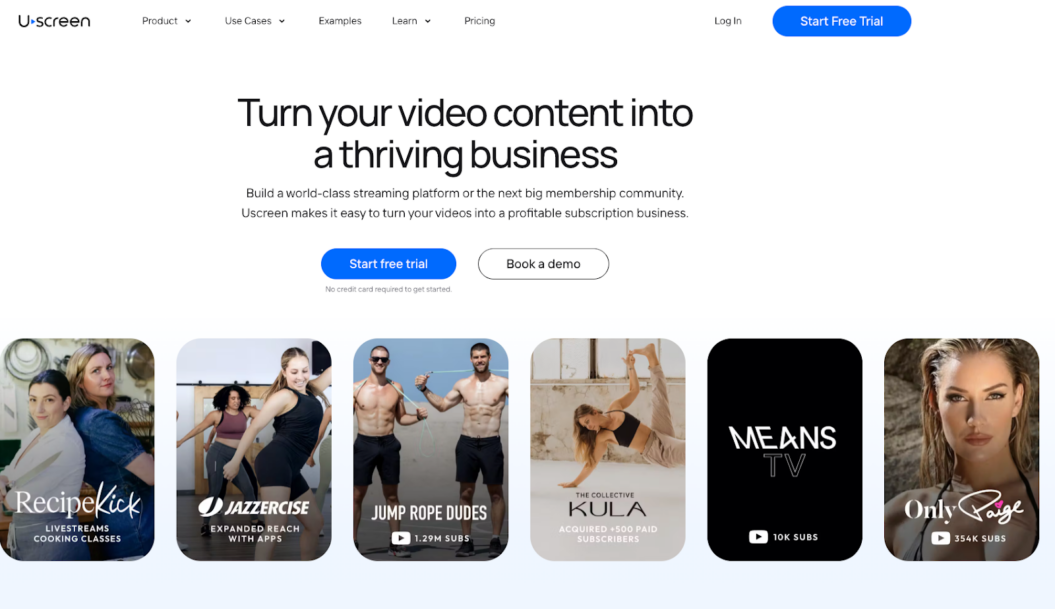
However, Uscreen isn’t designed for LMS-style courses — it’s better suited for Netflix-style viewing. It’s also more expensive than some Thinkific competitors, and its out-of-the-box themes may feel limiting if you need advanced customization.
Abundance Plus Launches Apps and Grows to $100k/mo in Revenue
Justin Rhodes, founder of the thriving homesteading community Abundance+, has seen phenomenal success since launching their custom app. The platform, which seamlessly blends education and entertainment, has achieved $1M in annual revenue and doubled its membership, boasting a 4.5-star rating in app stores.
Debuting in 2021 to cater to the growing interest in homesteading, Abundance+ offers a diverse range of content, including educational videos, masterclasses, documentaries, and behind-the-scenes vlogs. Its vibrant community and comprehensive content make it an essential learning resource for both seasoned homesteaders and those new to self-sufficient living.

Features we love
Here’s a closer look at what you’re able to achieve with Uscreen.
- Build a beautiful website: Uscreen’s website builder and fully customizable templates are designed to create sleek websites without any coding knowledge or experience. You have access to several customizable website templates and the ability to create custom pages and landing pages that are mobile responsive.
- Monetize your brand in several ways: Sell digital products and integrate your site with Shopify so you can offer a complete storefront with the opportunity to sell physical products, too.
- Build an engaged community: Start, manage, and carry conversations with members. Create posts, reach out via direct messages, send emails, run polls, and send push notifications about exclusive live stream community events you can host through your Uscreen account.
- Leverage analytics and data for better decision-making: Improve your business with insights on watch time and views to stats on live events, countries your customers are from, devices they use, and more.
- Integrate tools you need: Build a well-oiled business, with access to over 8,000 integrations with Zapier, including affiliate tracking and reporting, Google Tag Manager, order and conversion tracking tools, Mailchimp, and Google Analytics.
- White-label apps: Launch your own app to reach a stronger community and a more lucrative business by delivering content to your audience, no matter where they are.
Uscreen pros
- Community engagement: It’s easy to set up and manage a video membership website or course, share content, and engage with members all in one platform.
- High-quality video: Use live streams with real-time chats, pre-registration tools, and interactive calendars for a rich viewer experience.
- Customization options: Design and brand your site and apps.
- Powerful marketing tools: You get built-in email marketing, analytics, a no-code website builder, and other ready-to-use tools.
- Multiple monetization option: Sell digital products and merch on your site.
Uscreen cons
- Cost: Higher price point
- Additional member fees: $1.99 for Growth and $1.49 for Pro
- Limited LMS features: No quiz functionality, assessments, progress tracking, or certification features
Uscreen reviews
Uscreen has a huge range of features which not only improves my customers’ experience of the membership, but also my own ability to effectively present and market to my prospects and customers. These features have made a huge impact on my business — increasing my revenue from existing subscribers, improving customer retention as well as increasing my subscriber base.
Felicity W.
I think the impressive range of features comes down to Uscreen’s willingness to listen to creators’ feedback and their understanding of the art of selling memberships. They are a dynamic and innovative company, as well as being caring, attentive, engaged, and the feedback we receive from our users is that this daily connection with us is what keeps them subscribed.
The backend interface is really easy to use. There’s much fewer steps needed to upload content and this saves us a fair amount of time each week.
Uscreen pricing
- Growth: Priced at $149 per month plus $1.99 per paid member per month, it’s designed for creators growing a small video membership online. Create your own Netflix-style video catalog, deliver live-streaming events, and enjoy community features.
- Pro: Costs $499 per month with an additional $0.99 per paid member per month. Ideal for established creators looking to grow their communities and businesses.
- Plus: Tailored pricing designed for established creators looking for complete brand control across all devices.
Build, launch and manage your membership, all in one place.
2. Teachable
Best for: Selling online courses, coaching, and digital downloads
G2 rating ⭐: 4 out of 5

Teachable makes it easy to sell online courses, memberships, and coaching. They’ve carved out a unique position as a platform with a free plan that makes it easy for beginner creators to get started selling courses.
Its all-in-one feature set makes it an easy choice for starting and growing your course business. The ability to ‘do it all’ from one platform means greater convenience and less cost for additional apps.
If you’re getting started and want to launch your course ASAP, Teachable’s a great choice. But if you’re looking for a little more flexibility, it may prove limiting.
High transaction fees eat into your margins, and customization capabilities are limited. It is also not a SCORM-compliant platform, which is an important detail if you’re a formal education or professional development organization.
Features we love
- Engage students with in-depth quizzes, certificates, and progress tracking
- Boost revenue through upsells and order bumps.
- Sell more content through digital downloads.
- Grow your reach with affiliate marketing features.
- Enhance your site using Teachable’s App Hub 100+ app and 3rd-party integrations.
Teachable pros
- Intuitive website builder: The user-friendly drag-and-drop builder feels intuitive.
- Low cost: Explore the free trial to get started.
- Monetization options: There’s an option to upsell offers to boost average order value.
- Comprehensive student feature set: Quizzes, testing, and certificates of completion are available.
Teachable cons
- High transaction fees: You’ll be charged 5%-10% for sales you make.
- Customization limitations: The website builder lacks duplication features that speed up site builds. Branding capabilities are also limited.
- No SCORM support: Formal education and professional training organizations may find a lack of SCORM support a setback.
Teachable reviews
Ease to create courses and simple drag and drop website building. Now from the Teachable sales page transaction has become super easy. Loading video content is better than most of the LMS.
Shalinee K.
The limitation in the paid version is to have only five courses at a time. However, the pro version doesn’t have a limit. Also, pricing is on the higher side. Adding direct automation to enroll students from payment gateway will be a great feature.
Teachable pricing
- Free trial: $1 + 10% transaction fee and offers just enough to get you started with 1 published product of each type (course, coaching, downloads).
- Starter: $39/mo — includes a 7.5% transaction fee, with room to sell one published product, integrated email marketing, and other features like live group coaching and accelerator challenge access.
- Builder: $89/mo — 0% transaction fees. It’s ideal for creators looking to begin scaling their businesses, is backed by support, and comes with affiliate marketing features.
- Growth: $189/mo with 25 published products and the ability to white label your website, making it ideal for large-volume courses and product creators.
- Advanced: $399/mo — this is an enterprise solution that includes advanced theme customizations, unlimited integrations, custom user roles, and bulk student enrollment.
3. Podia
Best for: Selling digital downloads, webinars, courses, and coaching.
G2 rating ⭐: 4.4 out of 5
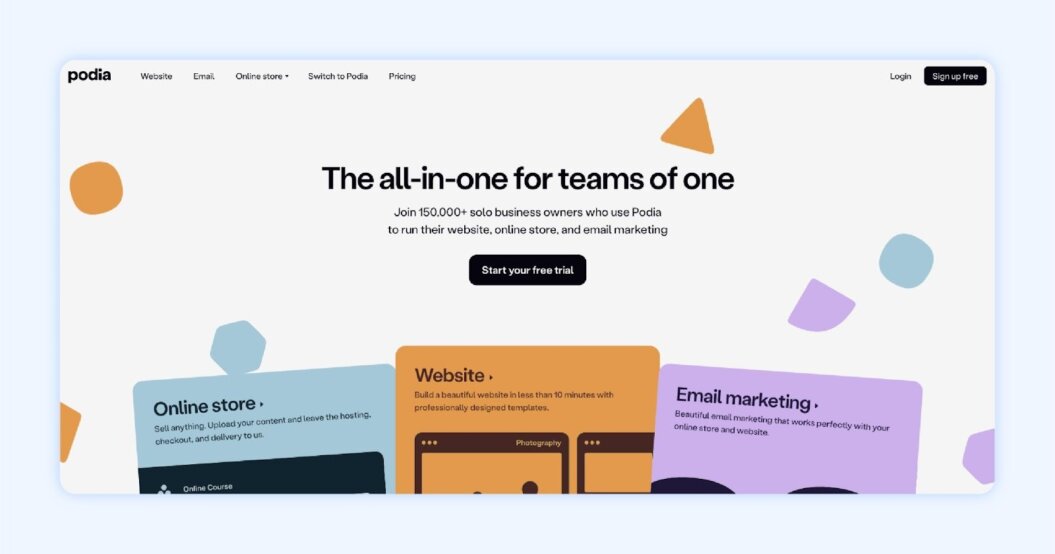
Podia works as the smart choice for one-person operations. Its easy-to-use website builder and beautiful designs make it easy for anyone to put together a site in the shortest time possible. And when it comes to monetizing your content, everything you need works in concert.
You may also appreciate Podia’s course creation tools, the option of hosting webinars, and other features like affiliate marketing management.
But there are a few details that may make you look for Podia alternatives. For starters, email marketing functionality is an add-on that comes with its own price tag. Transaction fees are pretty high, too. On Podia’s free plan, you’ll forfeit 10% of what you make, and that’s a significant amount for any creator.
Features we love
- Sell product bundles and flexible memberships.
- Drive sales using coupons, affiliate programs, and built-in email marketing.
- Automate workflows with integrations like Mailchimp, Kit, Google Analytics, Facebook, and others.
- Issue course completion certificates to students.
- Sell eBooks, music, and audio files.
- Engage learners with community tools like forum discussions.
- Offer drip-feed course content.
Podia pros
- Comprehensive features: It offers several all-in-one services.
- Intuitive website builder: Create stunning, code-free websites with ease.
- Low barrier to entry: Get started by exploring the platform for free.
- Flexibility: Integrations enable greater efficiency.
Podia cons
- Limited customization: Advanced creators may find the editor too restrictive for full branding control.
- Simple LMS features: Quizzes and assessments cover the basics but may fall short for creators with advanced needs.
- Digital product-focused: Unable to sell physical products, and the platform doesn’t support inventory management or logistics functionality for creators wanting more monetization avenues.
- High transaction fee: The free and Mover plans are at 10% and 5%, respectively.
Podia reviews
Easy to use. To build a site, a landing page, a course can go really fast. It looks good, clean and it’s also user-friendly for clients. I moved from a WordPress site because it’s easier with Podia, no need for updates or solving problems and, in the end, it isn’t that much more expensive (if it actually is). I cannot say something isn’t working well. There are one or two features I would like to have, like being able to copy lessons and modules from one course to another, but I guess it will evolve to that some day…
Raquel D.
Podia pricing
- Free: Offers one coaching product with a 10% transaction fee, one website and blog, draft courses, single download, create webinars, product bundles, and community resources
- Mover: $39/mo — lower 5% transaction fee, no limit on courses, coaching, webinar and product bundle functionality, and integrates with other tools
- Shaker: $89/mo — zero transaction fees and the ability to manage affiliate marketing programs
4. Kartra
Best for: Marketing and selling digital products and courses.
G2 rating ⭐: 3.9 out of 5
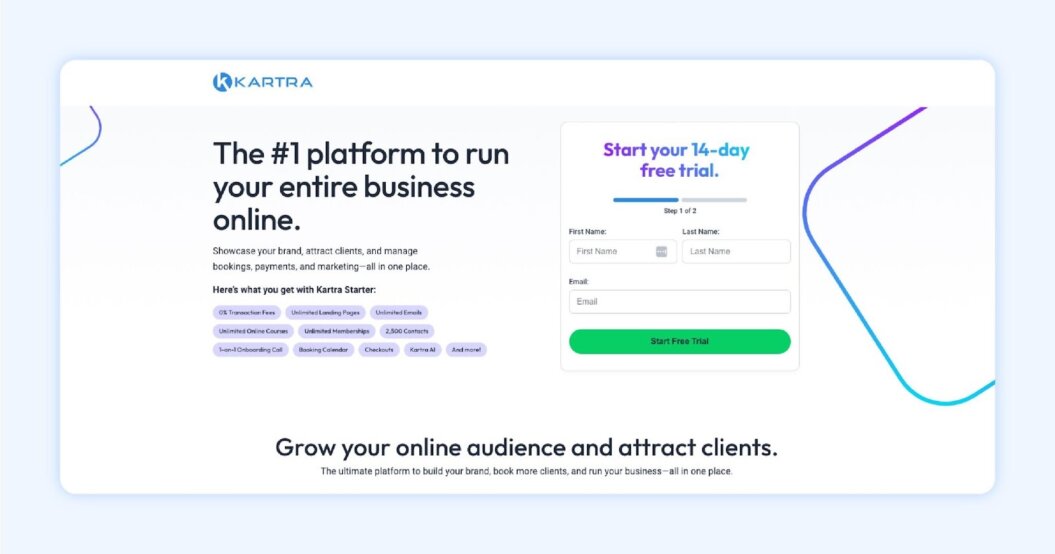
Kartra has created one of the most comprehensive platforms available today. It’s suited to course creators interested in advanced marketing capabilities along with split-testing capabilities.
Katra’s behavioral marketing functionality can serve up dynamic headlines based on your audience’s behavior, and this is all connected to the rest of your community for deeper insights. Building a site is simple, with 500+ customizable templates and a drag-and-drop editor, making it accessible for non-technical creators.
However, Kartra’s UX and UI can be challenging for beginners. The platform may feel overly complex due to its extensive features. It also lacks native blogging functionality, so creators wanting to establish thought leadership will need a WordPress integration, adding extra work. Pricing can also be high compared to simpler, more flexible course platforms at lower monthly costs.
Features we love
- Sell digital and offline products.
- Customize your video player with watermarks, brand colors/skins, CTAs, and prompts.
- Build websites and landing pages with customizable templates.
- Leverage plug-and-play marketing campaigns, automated emailing, and coupons.
- Sell one-off courses, offer payment plans, or establish a membership site with tiered pricing.
- Host surveys and quizzes that can trigger email sequences.
- Integrate with tools like Mailchimp, Kit, Google Analytics, Facebook, and more.
- Access detailed analytics reports on emails, page engagement, and marketing campaigns.
- Offer drip-feed course content.
Kartra pros
- Comprehensive design options and customization: It has 500+ templates to choose from with many customization options.
- User-friendly: It offers easy-to-use web page templates.
- Member engagement tools: Gather insights through surveys and test member knowledge with quizzes.
- Robust marketing and analytics: It includes behavioral adaptive marketing for smarter campaigns, along with analytics for sales, email marketing, and your funnel.
Kartra cons
- Limited customization: Site templates are restrictive, resulting in fewer branding capabilities.
- No native blogging functionality: You’ll have to integrate a 3rd-party tool.
- Feature-rich complexity: Kartra’s range of features make it robust but also potentially harder to work with for beginners.
- Cost: Pricing could be high for beginners and one-person creator businesses.
Kartra reviews
The payment management system. Nobody talks about it, but it is by far the best feature Kartra has. You can manage payments, cancellations, refunds, recurrent payments (including changing dates) all inside Kartra, no need to go to any of your payment processors. I don’t like that Kartra needs to use re-directions when you use custom domains. This slows down page load speed.
Gonzalo J.
Kartra pricing
- Essentials: $59/mo — 5 pages, 1 product, 1 membership/course, email and contact limits, 1 custom domain, Kartra AI, form builder, funnel mapper, analytics, checkouts, 100 pre-built campaigns.
- Starter: $119/mo — Unlimited pages, products, and memberships/courses, unlimited emails/SMS, 1 custom domain, Kartra AI, video hosting, 5 team members, calendars.
- Growth: $229/mo — Everything in Starter plus funnel simulation, webinars, advanced automations, affiliate management, surveys and quizzes, multiple domains, 10 team members, helpdesk support.
- Professional: $549/mo — Everything in Growth plus more contacts, additional domains, Kartra AI, real-time funnel analytics, live chat support.
5. Udemy
Best for: New creators or creators without an audience.
G2 rating: 4.5 | Trustpilot Rating: 1.8 out of 5
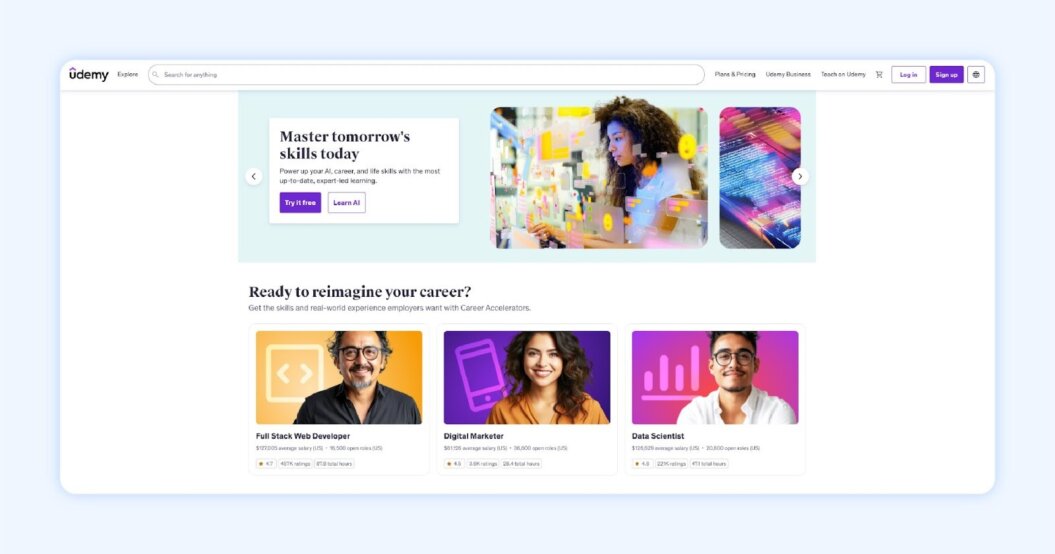
Udemy is almost an institution. Its simplistic, low-barrier design makes it appealing too. You don’t need coding skills or have to worry about the technical requirements of owning a domain, setting up email designs, or the look and feel of your course page. And once you’re set up, you can start selling online courses.
There’s a clear and almost intuitive feel, with a course creation process that is easy to follow. It offers a way to connect with students to answer questions, offer quizzes, provide completion certificates, and receive ratings for your course as students complete sections.
While this simplistic model may seem like a win for some, it’s just as easily a compromise for many. A lack of customization makes it hard for your course to stand out. This brings us to an equally challenging aspect of Udemy’s model: The marketplace dynamic, making pricing wars a reality, and the value of your course is potentially grossly discounted.
You’re also likely to feel a little pinch when it comes to Udemy’s revenue splits. As a creator, you’ll receive 37% when orders are placed without an instructor coupon or are not made through your unique course enrollment link.
Features we love
- Launch courses via iOS and Android apps.
- Stream content with a native video player.
- Claim dynamic discounts through Udemy Deals for your courses.
- Issue online course completion certificates to students.
- Include online course notes and other downloadables, including slides, PDFs, audio, and images.
- Host unlimited courses.
- Track analytics on your student progress, course engagement, and traffic sources.
Udemy pros
- Quick and easy setup: It’s perfect for beginners who want a simple and fast way to sell courses.
- Student support: You can upload supporting content for a wholesome learning experience.
- Low setup cost: There are zero fees for setup or hosting courses.
- Communication features: Engage with students on course-related questions and send mass email messages.
Udemy cons
- No customization: Udemy has set course and page designs.
- Expensive revenue split program: Udemy can take up to 57% of the revenue.
- Competition-heavy: Marketplace dynamics pit your course against potentially lower-priced alternatives that could appear more attractive.
- Aggressive dynamic discounts: Udemy’s dynamic discounting program could lower your course sales price, resulting in less revenue and profit.
Udemy reviews
Udemy is the best platform to sell course and earn money from it. We sell our courses on Udemy and it is very easy to upload the video course and sell them. Customer support is also very active on email. We have uploaded many courses on Udemy and it was a very easy task. We use Udemy for all our courses and track them daily.
Anirudh S.
Module section in the course can be made better, and visibility to new course is quite low.
Udemy pricing
Udemy offers a single revenue split program. Instructors receive 37% of the revenue from sales where no instructor coupon or course referral link was used, and 97% where purchases are made through an instructor referral link or coupon.
Note: Though Udemy Business receives a 4.5 out of 5 on G2, there is no rating for its consumer-focused platform, which is where your courses would be hosted. Though the Trustpilot score listed above is low, it’s worth considering this is from the consumer perspective. It’s worth researching how this might impact your customers’ experiences before committing.
6. Kaltura
Best for: Enterprises using video to educate staff and customers
G2 rating: 4.3 out of 5

Kaltura is ideal for enterprises looking to create courses with unique corporate training and potentially external (client-facing) learning experiences.
It’s packed with interactive features, like whiteboarding, polls, reactions, and more. Collaboration is another key feature, making chat, Q&As, and a feed during live streams a hit if you do a lot of live presentations.
It also offers a strong suite of standalone products that can be bundled, like Webinars, Virtual Classrooms, Virtual Events, and more. Pricing isn’t available on the site, and given that this is more of an enterprise-level platform, adding more tools to your stack could get expensive.
Features we love
- Add custom branding and skins for your video player, along with chapter break, dual-stream viewing, and closed caption options.
- Use its branded MediaSpace Go app.
- Sell video downloads and monetize your content with advertisements.
- Optimize with the AI agenda and content generator.
- Moderate community tools with polls, reactions, and confetti.
- Integrate learning tools like whiteboards, video quizzes, chaptering, and translations of your videos.
- Download PDFs, PPTs, audio, images, and more.
- Compare performance with native analytics for user and video performance.
Kaltura pros
- Comprehensive customization: The platform offers branding and customization options.
- Interactive tools: It has a host of engagement tools to enhance learning and audience experiences.
- Flexibility: It integrates with an already existing WordPress site.
- Advanced analytics: Native analytics include usage, engagement, content interactions, and more for developing improved audience experiences.
Kaltura cons
- Complexity: Kaltura is an enterprise platform with an extensive collection of features that could feel overwhelming for beginners.
- Pricing: While not available on its site, Kaltura’s feature set and target market is enterprises and potentially priced higher than competitor options.
- Add-on requirements: While comprehensive, expanding your requirements to include video conferencing, virtual events, webinars, and more will be at an extra cost, only available through contact with Kaltura’s sales team.
Kaltura reviews
I like that I can get metrics if students have watched the videos. I worry about the cost over the long term.
Michael L.
Kaltura pricing
When we last checked, Kalutura’s pricing was based on selecting single or multiple solutions, with most requiring custom quotes.
7. LearnDash
Best for: Entrepreneurs and businesses selling online courses
G2 rating: 4.2 out of 5
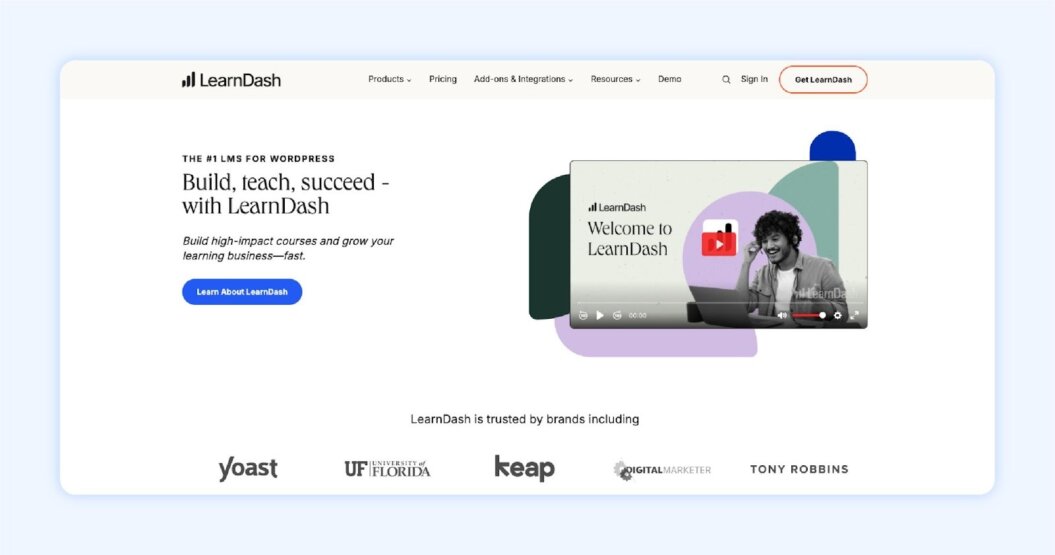
LearnDash is a WordPress plugin solution designed to transform your site into a learning management system and membership platform. It includes several key features course creators need, but for everything you’ll need to build a fully functional community-based business, you’ll have to invest in the LMS and membership plugins and several add-ons at an additional cost.
LearnDash’s pricing model is a little different than most. As an annual fee, your purchase gives you access to a slew of features, and this could be ideal for anyone looking for a simple one-off payment option. It also comes with 8 paid and 7 free add-ons, so there’s a good chance that you’ll find any and all functionality you need in LearDash’s ecosystem.
Going with LearnDash may not be a heavy investment depending on the bundle you build — and because licenses are sold as annual plans and can appear less expensive if protracted over 12 months.
A word of caution: You may not need all of LearnDash’s 8 paid plug-ins to run your business, but if you do, know that costs can easily grow over time.
Features we love
- Turn your WordPress website into a membership site.
- Offer drip-feed course content.
- Sell memberships, subscriptions, bulk access, bundles, and one-off purchases to your learners through a WooCommerce integration.
- Integrate WordPress plugins for email, marketing, analytics, and more.
- Offer audio, ebooks, or merchandise using eCommerce tools on your site.
- Add advanced quizzes and polls with certificates.
- Include gamification elements with points and leaderboards.
LearnDash pros
- Flexibility: Transform your WordPress site into a fully functional membership platform.
- Engagement features: Add gamification to enhance learning and community experiences.
- Multiple monetization options: Sell digital products, courses, or even physical merchandise.
LearnDash cons
- Costly bundles: Add-ons can quickly increase overall cost.
- Limited analytics: Reporting for quizzes isn’t available.
- Complexity: Setup and plugin management can be challenging for non-technical users.
- Difficult integration curve: Migrating existing courses into LearnDash is complicated.
LearnDash reviews
I’ve built a couple of websites with LearnDash now, and I’ve got to say that customer support is one of my favorite features. Just recently, Chandni, from their support team, helped walk my client through which plugins and addons we would want based on their feature requirements. As for LearnDash itself, the platform is incredibly easy to use. It is also a plugin and not a theme; which is great because themes are generally more of a pain to customize and will often conflict with other plugins.
Verified User
The only downside to using LearnDash in my experience is the loading time of some of the pages on the WordPress dashboard, but that is also very server-dependent. That being said it can take a while to upload courses purely based off that.
LearnDash pricing
- LearnDash plugin: $199/yr — drag-and-drop course builder, with all you need to create and sell courses
- Ultimate course creator bundle: $499/yr — includes LearnDash LMS, ProPanel 3.0, Instructor Role, Groups Management, Ratings, Reviews, Feedback, Notes, and Gradebook to make course creation within WordPress
8. LearnWorlds
Best for: Creating and selling interactive online courses
G2 rating: 4.7 out of 5
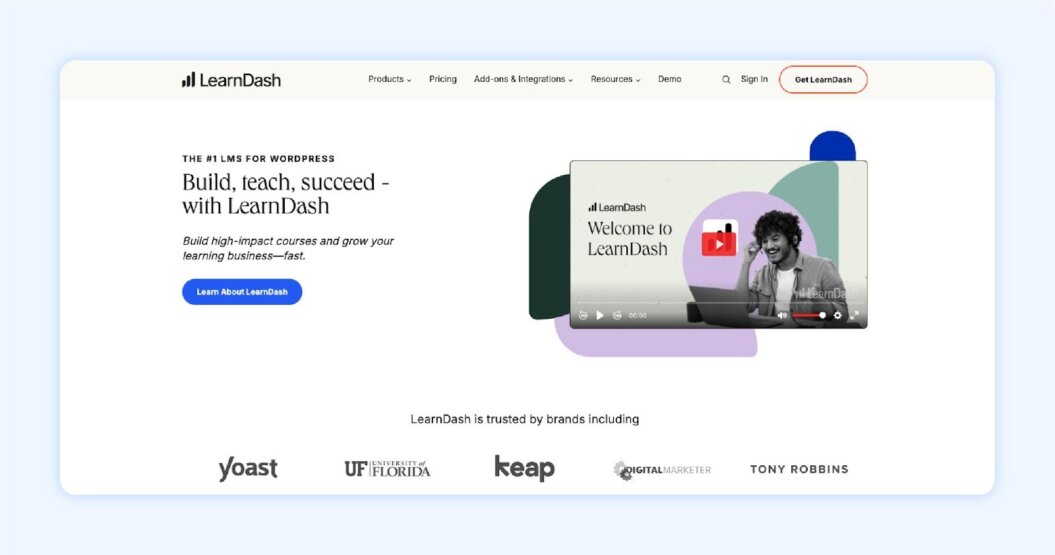
LearnWorlds is an AI-powered learning management system best for creators who want to design, sell, and scale highly interactive online courses. It’s built to go beyond standard course hosting, offering smart tools like automatic video transcripts, interactive quizzes, and customizable learning paths to keep learners engaged.
With 50+ professionally designed templates, LearnWorlds makes it simple to launch a polished, branded website without coding skills. For creators who value flexibility and ease of use, it provides an all-in-one solution for course creation, community building, and learner engagement.
That said, if you’re a creator who needs deeper customization or prefers more control over every design element, you may want to explore alternative platforms better suited for advanced development.
Features we love
- Create interactive courses with quizzes, transcripts, and flexible assessments.
- Engage learners using interactive videos and live sessions.
- Build your brand with 50+ templates, white-label sites, and mobile apps.
- Sell smarter through bundles, subscriptions, and affiliate programs.
- Track performance with advanced reporting and analytics.
LearnWorlds pros
- User-friendly: The intuitive interface and easy onboarding are perfect for beginners.
- Feature-rich: It offers interactive videos, assessments, SCORM/HTML5, and community tools.
- Integrations: It comes with 4,000+ options that connect with your existing tech stack.
- Supportive: Responsive customer support and dedicated success managers are there when needed.
- Branding flexibility: Create white-label websites and mobile apps.
LearnWorlds cons
- Design limitations: Fonts, layouts, and styling options can feel restrictive.
- Missing integrations: Some key tools, like HubSpot or Marketo, aren’t included.
- Learning curve: Advanced features and backend navigation can be tricky.
- Occasional bugs: Editing and course management have minor quirks.
- Cost at scale: Advanced add-ons and enterprise features can get expensive.
LearnWorlds reviews
LearnWorlds is designed for today’s education teams who need to build and iterate on content rapidly without needing to engage in prolonged development processes that result in SCORM files. LearnWorlds is flexible and straightforward, easy enough for anyone to develop in unblocking companies cross departmentally. Compared to the old tools my teams velocity has increased by at least 50% in all cases and we no longer need to rely on a web developer as well. This self contained tool empowers Education leaders. The support team is immediately responsive and helpful and we were able to implement and deploy without needing any hand holding.
Alexander A.
This is not dislike, just fact, LearnWorlds has many integrations and a few key ones (Marketo, Salesforce) are absent. These are also expensive integrations so the absence keeps the cost down. Not a dislike, a balanced fact.
LearnWorlds pricing
- Starter Plan: $29/mo — Create unlimited courses, eBooks, quizzes, 1:1 and group sessions, plus a 3-page website with payment gateways
- Pro Trainer: $99/mo — Unlimited courses, live classes, customizable course player, branded app, subscriptions and memberships, and 5 admins/instructors
- Learning Center: $299/mo — Interactive AI videos, advanced assessments, multi-account conferencing, school cloning, detailed reporting, 25 admins/collaborators
- High Volume and Corporate: Custom — Premium cloud servers, advanced SSO, flexible user/admin management, tailored pricing, dedicated success manager, 24/7 support
9. Kajabi
Best for: Marketing and selling digital products, courses, and coaching
G2 rating: 4.3 out of 5
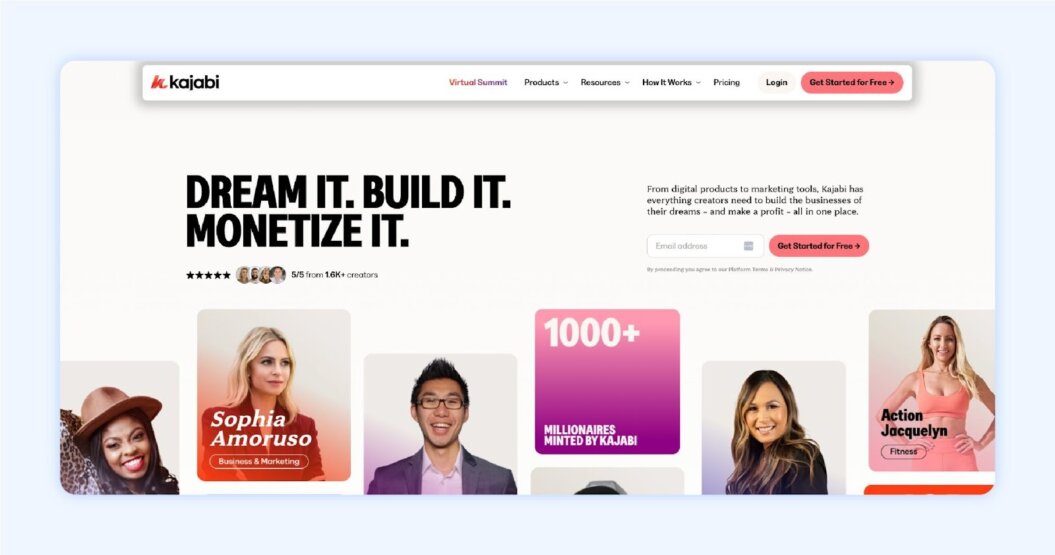
Why choose Kajabi?
Kajabi is an all-in-one platform designed for creators, coaches, and entrepreneurs looking to build, market, and sell online courses, memberships, and digital products. Its main strength lies in marketing automation, email campaigns, sales funnels, and payment processing, making it easy to manage your business from a single platform.
Kajabi is less focused video learning content or advanced LMS functionality compared to Mighty Networks. If course customization options and interactive learning features are priorities, other platforms would be a better fit.
Features we love
- Create courses with video, audio, PDFs, and downloadable resources.
- Engage your audience with memberships, drip content, and community features.
- Build your brand with customizable websites, landing pages, and email campaigns.
- Sell smarter with subscriptions, one-time purchases, and promotions.
- Track performance with sales metrics, marketing analytics, and basic course insights.
Kajabi pros
- Multiple monetization options: Sell courses, memberships, coaching, podcasts, and communities.
- Membership and subscription support: Build recurring revenue models with flexible payment options.
- Feature-rich platform: It includes a website builder, landing pages, sales funnels, email marketing, live streaming, and apps.
- Affiliate marketing: It also comes with native affiliate tools with automatic link generation and reporting.
- 24/7 support and resources: Access live chat, knowledge base, and tutorials.
Kajabi cons
- Limited course platform: Video hosting, analytics, and interactivity features are not as robust as dedicated LMS platforms.
- Complexity for new creators: Multiple products and features can be overwhelming to manage.
- Customization limitations: Landing pages, checkout pages, and website templates offer limited flexibility; advanced customization may require paid experts.
- Content management issues: Search, organization, and handling large video libraries can be cumbersome.
- Automation and analytics inconsistencies: Funnels, email sequences, and reporting can be unreliable at times.
Kajabi reviews
I like the ease of use for backend training course setup and the features they offer. Integration with Zapier was pretty easy in terms of offering access as soon as purchased with a stage in Pipedrive.
Samantha E.
It was not as friendly for exploring their other features, I couldn’t do it myself we needed a team of experts to come in and design the layout.
Kajabi pricing
- Kickstarter: $71/mo — perfect for launching and serving a small community
- Basic: $119/mo — designed for creators with up to 1,000 members in their community
- Growth: $159/mo — ideal for creators looking to expand their community and product offerings
- Pro: $319/mo — tailored for established creators needing advanced features, custom branding, and more
- Enterprise: Custom pricing — built for large organizations with high growth and scaling needs
10. Mighty Networks
Best for: Building community-driven memberships and learning hubs
G2 rating: 4.6 out of 5
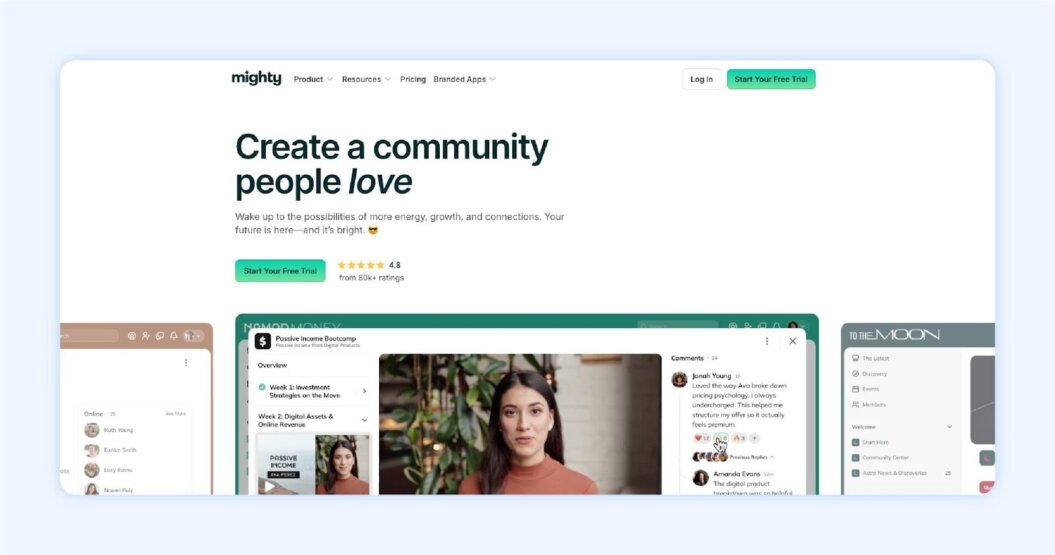
Mighty Networks is a platform designed for creators, coaches, and entrepreneurs who want to build thriving online communities around their expertise. It focuses on connecting members, fostering engagement, and offering courses or memberships in a social-first environment.
Unlike traditional LMS platforms, Mighty Networks emphasizes community-driven growth, with features like discussion forums, live events, and member profiles at the core of the experience.
Features we love
- Engage your community on discussion forums, private groups, and member profiles.
- Sell courses, membership plans, events, or subscriptions.
- Host live events like webinars, workshops, and Q&A sessions.
- Use a branded mobile app.
- Organize content for easy post navigation and access events or courses.
Mighty Networks pros
- All-in-one platform: Courses, memberships, events, and community are all in one place.
- Strong community focus: Members can interact, post content, and join groups easily.
- Flexible monetization: Sell subscriptions, courses, and event tickets.
- Easy setup: It has an ntuitive interface — minimal technical skills required.
Mighty Networks cons
- Limited course features: It has less advanced LMS functionality compared to Thinkific or LearnWorlds.
- Mobile app limitations: Some users report reduced functionality on mobile.
- Pricing: It can get expensive as your community grows or you need advanced features.
- Design flexibility: Customization options for course layouts and branding are limited.
Mighty Networks reviews
What I like most about Mighty Networks is how well-designed it is for building real community. It allows me to create courses, host discussions, manage memberships, and deliver content — all from one single, organized platform. Everything feels integrated and easy to use, which makes it perfect for running an engaged and professional online space.
Raul F. | G2
The initial registration and payment process can sometimes be a bit confusing or frustrating for new members. It’s not always as smooth or intuitive as it should be. However, once you’re in, the platform is truly outstanding and delivers an amazing experience.
Key platform features for content creator success
When choosing a Thinkific alternative, it’s important to focus on the features that will help your content business thrive. Look for tools that make course delivery seamless, engage your students effectively, and support sustainable growth for your online courses.
Here are 7 features you’ll need to sell online courses and build a thriving business.
Monetization
A strong Thinkific or Patreon alternative helps you monetize your content in multiple ways. The ability to upsell customers and offer digital downloads can easily create higher average order values and a stronger bottom line for your business.
Bonus points if monetization features also include subscriptions and pay-per-view options, instead of just selling online courses.
Customization and branding
Pick a platform that’s flexible enough to update and easy enough to customize as your business evolves. Being online means testing new ideas, including site layouts, messaging, and graphics to see what resonates with your target audience.
The easier it is to make these changes and deliver a polished and attractive site, the better.
Community and audience engagement tools
Communities are the lifeblood of creator-led businesses. People gravitate toward groups they identify with. The best online community platforms prioritize engagement between you and your audience, and open that experience to every community member.
If you’re able to build an online community alongside your content, the stronger your business will be.
Integration and compatibility
No matter what online course platform you choose, chances are you’ll need to integrate a 3rd-party tool at some point. Figure out what integrations you’ll need and whether the platform you’re considering makes them accessible and easy to work with.
Analytics and performance tracking
A great online course platform should make it easy to figure out how your business is performing. Look for analytics on student progress, course engagement, sales, and traffic sources, along with on-demand reports to make data-driven decisions and optimize your offerings.
Detailed analytics and reporting are important features to consider when making your decision.
Migrations
If you decide to switch to a new platform, verify that you can easily migrate your content and customers over. Migrations can seem like a massive undertaking, but a good platform does the heavy lifting for you and keeps you in the loop throughout the process. Look for a platform that handles migrations well — your future self will thank you.
Reliability and support
The best online course platforms step up whenever you need support. Whether you need some expert guidance in setting up your platform or support in fixing an issue, make sure your platform of choice offers reliable support. Customer reviews will be the biggest help in figuring out which platform lives up to its promises!
Simplify course creation and monetization with Uscreen
Many creators look for Thinkific alternatives after hitting limits around monetization, customization, and scalability. They often need more flexible pricing, subscription models, or better tools to deliver and promote video content.
Uscreen fills these gaps with an all-in-one platform optimized for video monetization, memberships, and marketing. Creators can sell courses, subscriptions, or tiered memberships while leveraging built-in marketing tools, analytics, and custom branding opportunities.
Plus, Uscreen reaches audiences across web, mobile, and TV apps, making it easier to grow a scalable, revenue-driven creator business.
Build, launch and manage your membership, all in one place.
FAQ
There’s always more to know when you’re making a business decision.
In case we haven’t covered everything you need up top, we’re going to answer some of the common questions that pop up about alternatives to Thinkific.
An online course platform is a web-based platform where course creators can host and sell effective online courses. They typically include a range of services especially designed to support learning, communication, reporting, and more.
There are several types of online course platforms, each with a range of features that better accommodate specific course creators’ needs. These needs depend on factors like the type of business and the learning style of your audience. Other factors include:
Your budget
Technical expertise
Whether you want to build an online community around your business
For these and other reasons, identifying the “best online course platform” really comes down to finding the one that aligns best with your unique needs and priorities.
Thinkific can host your course, and you’ll be able to sell memberships, too. However, it comes with limitations that could make scaling and building a thriving community and brand more challenging down the line. These include:
Fewer customization options than other platforms
Requires the highest plan to remove Thinkific branding
No native live event tools, so branding depends on 3rd parties
Limited video consumption data makes it hard to see what learners enjoy or struggle with
Can only sell courses, not other digital or physical products
Open catalog functionality is missing, restricting navigation options
Considering these limitations, Thinkific could be an ideal solution for new course creators and less so for established creators wanting to scale their businesses.
When comparing Thinkific and Kajabi, the best platform depends on your needs. Thinkific excels in course delivery and customization, while Kajabi offers an all-in-one solution with built-in marketing tools.
For those exploring alternatives, sites like Kajabi and Uscreen provide video-first solutions for creators looking to monetize their content.
When comparing Thinkific vs. Teachable, both platforms have strengths and are suited for different uses.
Thinkific excels in customization and branding — ideal for businesses and creators who want full control — while Teachable’s simplicity and built-in marketing tools work best for beginners or those focused on course sales.
Thinkific isn’t free, but it offers a 30-day trial so you can explore its features before committing to a Basic, Start, or Grow plan.







